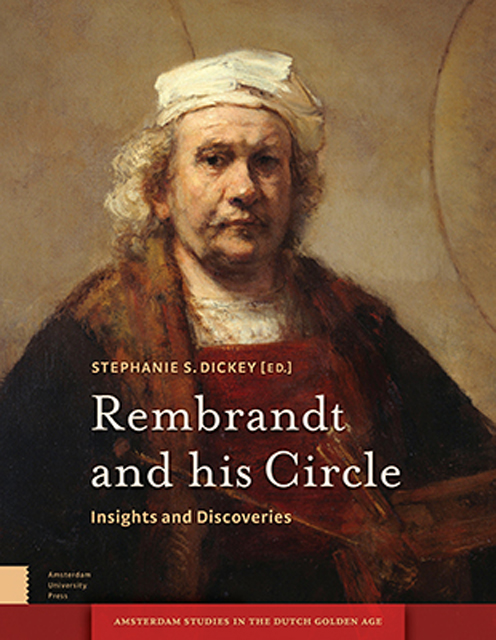Book contents
- Frontmatter
- Dedication
- Contents
- Acknowledgements
- Introduction
- 1 Rembrandt and Frans Hals Painting in the Workshop of Hendrick Uylenburgh
- 2 Rembrandt and the Germanic Style
- 3 Rembrandt and the Humanist Ideal of the Universal Painter
- 4 Curiosity and Desire: Rembrandt’s Collection as Historiographic Barometer
- 5 Painted Landscapes by Lievens and Rembrandt : The View from Seventeenth-Century Amsterdam Collections
- 6 Jan Lievens in Antwerp: Three Rediscovered Works
- 7 Gerrit Dou as a Pupil of Rembrandt
- 8 A New Painting by Jan van Noordt in Budapest
- 9 Rembrandt’s First Nude? The Recent Analysis of Susanna and the Elders from Rembrandt’s Workshop
- 10 Rembrandt’s Head of Christ: Some Technical Observations concerning Matters of Style
- 11 A Rediscovered Head of John the Baptist on a Platter from Rembrandt’s Studio
- 12 Rembrandt’s One Guilder Print: Value and Invention in ‘the most beautiful [print] that ever came from the burin of this Master’
- 13 Rembrandt, Ferdinand Bol, and Tobit: The Emergence of a Pathosträger
- 14 Biblical Iconography in the Graphic Work of Rembrandt’s Circle
- 15 Jan van Vliet and Rembrandt van Rijn: Their Collaboration Reassessed
- 16 Printmaking among Artists of the Rembrandt School
- 17 Chain Line Pattern Matching and Rembrandt’s Prints
- List of Illustrations
- Bibliography
- Index Nominum
11 - A Rediscovered Head of John the Baptist on a Platter from Rembrandt’s Studio
Published online by Cambridge University Press: 21 January 2023
- Frontmatter
- Dedication
- Contents
- Acknowledgements
- Introduction
- 1 Rembrandt and Frans Hals Painting in the Workshop of Hendrick Uylenburgh
- 2 Rembrandt and the Germanic Style
- 3 Rembrandt and the Humanist Ideal of the Universal Painter
- 4 Curiosity and Desire: Rembrandt’s Collection as Historiographic Barometer
- 5 Painted Landscapes by Lievens and Rembrandt : The View from Seventeenth-Century Amsterdam Collections
- 6 Jan Lievens in Antwerp: Three Rediscovered Works
- 7 Gerrit Dou as a Pupil of Rembrandt
- 8 A New Painting by Jan van Noordt in Budapest
- 9 Rembrandt’s First Nude? The Recent Analysis of Susanna and the Elders from Rembrandt’s Workshop
- 10 Rembrandt’s Head of Christ: Some Technical Observations concerning Matters of Style
- 11 A Rediscovered Head of John the Baptist on a Platter from Rembrandt’s Studio
- 12 Rembrandt’s One Guilder Print: Value and Invention in ‘the most beautiful [print] that ever came from the burin of this Master’
- 13 Rembrandt, Ferdinand Bol, and Tobit: The Emergence of a Pathosträger
- 14 Biblical Iconography in the Graphic Work of Rembrandt’s Circle
- 15 Jan van Vliet and Rembrandt van Rijn: Their Collaboration Reassessed
- 16 Printmaking among Artists of the Rembrandt School
- 17 Chain Line Pattern Matching and Rembrandt’s Prints
- List of Illustrations
- Bibliography
- Index Nominum
Summary
Abstract
This essay examines a previously unpublished painting, Head of John the Baptist on a Platter, acquired in 2013 by a private collector in Canada. The figure closely resembles the series of small ‘Heads of Christ’ painted by Rembrandt and his studio beginning around 1648, suggesting the use of the same model. Technical examination confirms that the materials are consistent with this date and place, but the composition is inconsistent with Rembrandt's approach to iconography. Rather, it seems to be the kind of studio invention Rembrandt encouraged his pupils to make. The use of this figure in Rembrandt's studio for a character other than Jesus supports documentary evidence that these heads were painted ‘naar het leven’ (from a live model).
Keywords: Rembrandt van Rijn, Rembrandt workshop, John the Baptist (Head of), technical art history
Rembrandt's interest in developing a new, ethnographically accurate model for the face of Jesus is well documented and evident in his works beginning around 1648. The new head type appears in a series of up to eight small oil sketches developed in his studio, as well as the Supper at Emmaus of 1648 and the Noli Me Tangere of around 1650. Rembrandt made very few paintings in the later 1640s, but nearly all feature the new model of Jesus. This face also appears in etchings including The Hundred Guilder Print (c. 1649) and La Petit Tombe (c. 1652). While several sources confirm Rembrandt's use of a living model to achieve this new image, doubts remain. Did a real young man pose for the sketches, and was he Jewish? Was the new model after life (naar het leven) or from the imagination (uyt den gheest)?
In July 2013, a small (25 × 28.4 cm.), Rembrandtesque panel painting of the head of John the Baptist on a platter appeared on the art market. It was immediately clear that the same model was employed in this work as the one used for Rembrandt's novel image of Jesus. The painting is now in a private collection and is here reproduced in the scholarly literature for the first time (fig. 11.1 and pl. 11.1).
- Type
- Chapter
- Information
- Rembrandt and his CircleInsights and Discoveries, pp. 223 - 229Publisher: Amsterdam University PressPrint publication year: 2017



